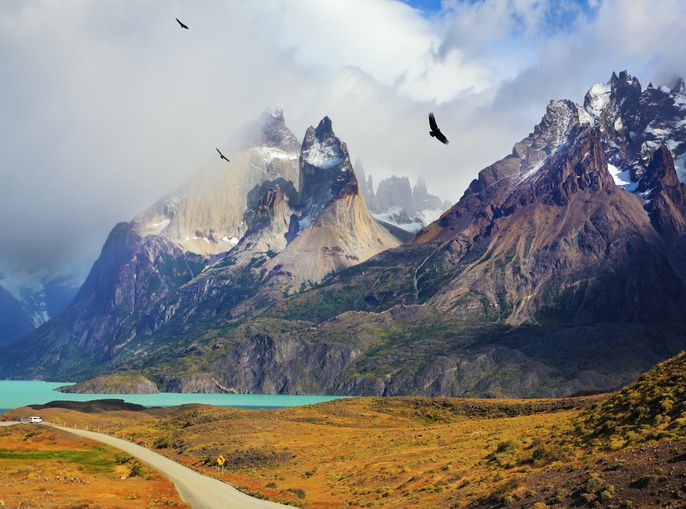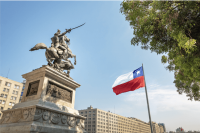Patagonia is known for its spectacular scenery of ice-capped mountains, crystalline lakes and ancient glaciers. But most of these features are concentrated in the north-south band surrounding the Andes Mountains that divide Chile and Argentina. The majority of the landscape is covered by the Patagonian steppe – a flat, treeless plateau with a cold dry climate extending east to the Atlantic coast.
This extreme range of landscapes is home to different climate zones. And wind – lots of wind. The weather in Patagonia ranges from temperate in the north in summer, to subpolar down south, and from high humidity and heavy rains in the mountainous strip, to semi-arid zones and desert in the eastern tablelands where it rains little or barely at all.
The wind is a constant in Patagonia in both the mountainous and flat regions. Winds can reach 50 km with gushes up to 100 km. But thankfully, it is intermittent. There can be days of complete calm, (which can also be followed by weeks of rough weather!).

Mountain Weather
The mountainous regions are known for wild weather that can change several times in a day. Varying degrees of cutting winds, freezing cold, rain, and snow affect these areas in the winters – in Bariloche or Calafete for instance, or Ushuaia, the southern-most town on Earth, where the temperature can drop several degrees in minutes.
In summer, make the most of any good weather immediately for excursions or treks, and all year round make sure to pack layers (see What to Wear below), because one day does not safely predict the next, or even later the same day.
Weather on the Patagonian Steppe
The steppe region is mostly cold and dry with desert and semi-desert systems, with snow in the long winters and year-round frosts. Fall and spring are short like the rest of the southern cone, while summer in the north is warm.
The steppe region has few trees and not many people – Patagonia is one of the most sparsely inhabited regions on Earth. But it is home to many native species of animals including the Patagonian mara, chinchilla, Patagonian weasel, Argentine gray fox, and the guanaco. It also features natural reserves including Perito Moreno National Park, Los Glaciares National Park, the Bosques Petrificados Natural Monument, and many others.
Places of Interest and Weather Concerns
A good starting point for hiking, San Carlos de Bariloche is a hub in the north of Patagonia and the Lakes District. It is located in the foothills of the Andes, near large glacial lakes. In Spring the region bursts with the colors of blooming wildflowers. If you get stuck here in rain, hunt down the chocolate Bariloche is renowned for in the shops on Calle Mitre.
Further south, Calafete is a good base to explore the Los Glaciares national park. This is the location of the famous 5-kilometer glacier Perito Moreno, where you can get up close to the wall of one of the only glaciers in the world in constant growth. The winters are very cold and snowy. With the dry air you don’t feel the extreme cold but it is important to dress properly. There is lots of snow in the winter months and it is windy and cloudy year-round.
Weather at the End of the World
At Cape Horn, AKA the End of the World, the convergence of the Atlantic and Pacific Oceans mediates the climate and the Andes Mountains bring abundant rains to the islands.
The weather can be extreme and unpredictable with rapid changes throughout the day. In summer, it might rain in the morning, followed by a light snow, followed by a sunny afternoon then extreme wind.
Cape Horn is barely 1000 kilometers from Antarctica, so the winds can be fierce. And it is very cold – even when the sun shines. In January, the hottest month, you may still need thermals and a beanie.
The Seasons
Patagonia is well-known for its long winter, short spring and autumn, and well differentiated seasons. The autumn is ideal for photographers with stunning warm colors of the changing leaves.
Summer is the best time to visit, when the most activities are accessible, safe and available. Kayaking, canoeing, and certain cruises only run in the summer. Some activities run in the winter such as glacier trekking, and of course winter is best for skiing.
For snow in the ski resort of El Cerro, go in winter. It can snow any time of the year, but is not guaranteed at other times.
Delay May
Heavy rains begin in May so it isn’t the best time to go to Patagonia. It is low season so a lot of activities are not be available, though you will avoid crowds and get good prices on hotels. Many locals take their vacations in the low season, May in particular, so it can be difficult to access some services.
Practical Tips
- If you are considering going on an excursion and it’s a nice day, go immediately because the weather in Patagonia can change at any time.
- Take appropriate clothing. There are options locally but they are not cheap.
- In winter take extra batteries for phones and cameras – the cold drains battery life faster than in warmer climates.
What to Wear
Layers – take three.
- Basics: Long sleeve thermal shirt, (possibly also thermal pants), quick-dry trekking pants, light-weight polar fleece. Strong, waterproof hiking shoes and running shoes for easier walks.
- Winter: waterproof gloves, cold weather hat with ear flaps, long socks and light-waterproof windbreaker, a scarf and a down parka.
- Summer: trekking sandals are useful, a sunhat is essential, plus a back pack, water bottle, hiking poles, headlamp for safety, bags for trash to take it with you.
No comments yet
There are no comments on this post yet.




Leave a comment